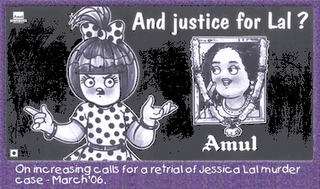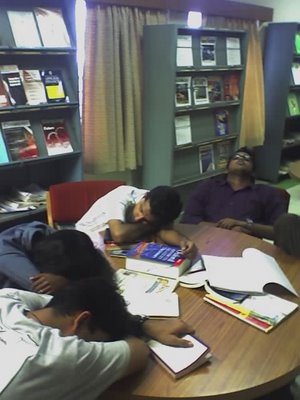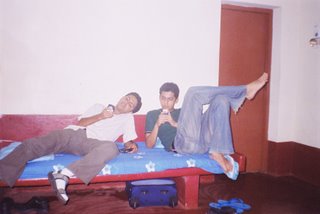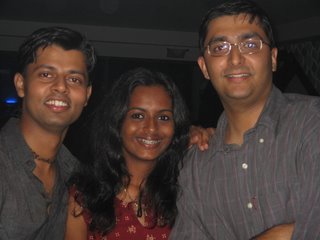Empty MT....!!
Case Study
DILEMMA OF MANAGEMENT TRAINEE
Khushdeep Dharni
Submitted on July 31st 2006 as part of “Individual as a Decision Maker” – PGP I Section II
Sanat Satyan Roll no 2006251
What should Abhinav do?
The “Dilemma of Management Trainee” can be analyzed once one has answered the following set of questions regarding the facts of the case presented before us.
Who is Abhinav?
Abhinav Chadha, a Mechanical Engineering Graduate, hails from a middle class family and aspires to make it big in the business world. After his Engineering degree, he pursues his Masters in Business and specializes in Marketing Management in the same course.
The year he passes out of his institute sees a grim state in the job scenario in the country. The Pokhran Nuclear Tests by the Indian Government and the Stock Market Scams are the reason for a slump in the Indian Economy and the job market in the country.
Still, Abhinav manages to get a good placement. His first job, right after his Masters, as a fresh Management Graduate, is in Abhishek Spinning Industry Limited (ASIL). Which is a good paymaster and offers reasonable package to Management Trainees across institutes.
What do we know about Abhishek Spinning Industries Limited (ASIL)?
With 20000 spindles in 1990s to being amongst the Top 10 Cotton Textile Companies in India, it has taken ASIL some time to become a Rs 1000 crore business entity. Starting in 1980s as an Agro Manufacturer in Punjab, ASIL has come a long way to having interests in Chemicals, Yarn, IT and Biotechnology and presence in both domestic and international market. ASIL plans to maintain its status as one of the largest producers of Agro based paper and expand in the future at the rate of 40% CAGR. To achieve the same, it is highly open to new ideas in Management and implementation of the same in the company.
ASIL recruits 1st class candidates from premier management institutes in the country every year for the post of ‘Management Trainee’. Its two-level recruitment process, set according to ISO standards, tests aspirants both on knowledge grounds and psychological aspects. A two-stage Group Discussion, rigorous Management related Interview, Physical and Medical test and a final interview with the MD of ASIL, see to it that only the most deserving candidate gets into the company. In turn, it looks forward to the growth opportunities it can provide to each of the new entrants.
What is Abhinav’s position in Abhishek Spinning Industries Limited?
Abhinav is recruited by ASIL right after his graduation in Business studies. As a ‘Management Trainee’, he has to undergo a 6 months ‘Induction Programme’ in the organisation, during which he will be posted in a particular department, right after the first week.
Materials
Abhinav Chadha has specialized in Marketing Management during his Masters in Business. He is very happy to join ASIL and is looking forward to an exciting time in the company. One of the Interviewees during the recruitment process selects him to be a part of his own division – “Materials”.
The third week in the organisation sees Abhinav being given the responsibility of heading the ‘Stores’ Department of the ‘Materials’ section. Abhinav now has six people reporting to him in that department, which looks at the ‘Receipt’ and ‘Issue’ of Materials. His reporting authority is the head of the Materials Section i.e. Mr. Rajesh Sharma (Vice President – Commercial).
So, where is the dilemma for Abhinav?
Being a new entrant in an organisation and having spent only 6 months during the training period, Abhinav faces a few initial challenges in the company. However, he chooses to resign near the end of his induction programme for a job in Marketing in a lesser known company. On being talked to by the Mr. Mann, he is now in a dilemma.
The problems that Abhinav has identified in the organisation are as follows.
Abhinav identifies a few people in the organisation who are the source of discomfort to others or are misfits for their job profiles. The first one worth a mention is his own boss, Mr. Rajesh Sharma (VP – Commercial). Mr. Sharma is not adept with the skills of handling a Stores department. He has a background in Finance and Law and prior experience of Purchase and Dispatch. He is unable to handle the Stores department because of its inherent problems.
Abhinav fails to see here that probably as a Manager, Mr. Rajesh Sharma is aware of his shortcomings. He understands that he is not able to handle the Stores section so he was very skillfully looking for a suitable candidate to head the same department. Since he was one of the interviewee, he took it as an opportunity to look for a suitable person to handle this department and chose Abhinav for the post. One should not undermine the capabilities of Mr. Sharma on this ground, as the performance of Abhinav in the last six months has proved the fact that he has been successful in finding the right person for the post (very well realizing his own shortcomings!).
The second important character in the ‘Stores’ department, whose ‘expertise’ & ‘absenteeism’ was a cause of worry, was Mr. Kulwinder Singh.
Mr. Kulwinder Singh is a Store Assistant under Mr. Gurwinder Dhaliwal, one of the two Store Officers. Out of the six people in the ‘Stores’ section, he is the only person who is ‘Computer Literate’ and is able to handle the newly implemented software with ease. For this reason, the entire section depends on him for any kind of report generation and data handling.
One can see this person in two lights.
First, with a sympathetic view, one can see that since Mr. Singh is under too much pressure from the department to work in the computer (taking the load of the entire department during month ends at times), he is not keeping well and is absent from work for the same reason.
Second, it is possible that Mr. Singh enjoys his importance and acknowledgement of skills at the workplace and just to act more important amongst his peers and increase their dependency on him at crucial moments, he does not come to work. His expertise in this case is making him relaxed and egoistic. He is behaving in this way just to gain the importance in the Store section (and perhaps the IT people).
Mr Harnek Singh, the Store Officer in charge of the Receipt of the materials, is the third most important person in consideration. Let us study his character in detail.
Aged 50 years & a great amount of experience in handling stores, Mr. Harnek Singh comes across as one of the most indispensable person at first sight. However, Abhinav comes to know of various new things about him from various sources, which completely shatters the above beliefs.
- There is an on-going rivalry between the two Store Officers in the Store Section - Mr. Harnek Singh and Mr. Gurwinder Dhaliwal.
- Mr. Harnek Singh does not obey the instructions of Mr. Rajesh Sharma at times, who is his reporting authority.
- He refuses to cooperate with his peers in the section many times.
- According to other ‘Employees in the Stores Section’, he is stubborn and a ‘man of the Joint Managing Director, Mr. B.S. Mann’. Abhinav identifies this as one of the most important reasons why Mr. Sharma has not been able to deal with him till now i.e. taking stern actions against him. He himself does not want to take the risk of handling Mr Singh so that he does not offend the Joint MD!
- According to ‘Mr. Gurwinder Dhaliwal’, Mr Harnek Singh was responsible for some ‘Financial bungling’ in a previous mill in Punjab. He points out that the police are in search of him and he is on the run. (Mr. Dhaliwal substantiates his point by stating that Mr Singh stays within the factory premises all the time and does not step out of the Factory gate ever - in order to not get noticed.)It is important to look at this matter with close scrutiny.
Why should Abhinav believe Mr. Dhaliwal’s word? Probably, since there is tussle going on between the two Store Officers, Mr. Dhaliwal is putting words into his new boss’s ears in order to get into his good books or settle his scores with Mr. Singh. Since Abhinav till now, has not come across any substantiate proof regarding the same, he should not take Mr. Dhaliwal’s words at face value.
Only news about the acts of misbehaviour and rudeness has reached him (and he has not been talked to rudely by him as well) which can be caused by extreme work pressure to a 50 year old person in a hostile Store section of a textile mill! Also, with the automation of the Store Section and all the limelight going on Mr. Kulwinder Singh, it might be possible that Mr. Harnek Singh would be reacting to that in a negative way!
However, if Abhinav finds proof and concludes that Mr. Harnek Singh is a ‘problem child’, then one will have to look into this matter from a totally different angle and solve it.
Processes
Besides people issues, there are inherent problems in the Store Section itself, which need to be addressed with urgency. One can recognize the following operations related problems which are putting Abhinav in a dilemma.
Þ From the data given in the case, it is mentioned that the Total Inventory Value of the ‘Materials’ section was Rs 1 crore. Also, the Store people inform Abhinav that the Average Inventory value should be Rs 72 lakhs. With my limited knowledge of the ‘Materials’ department, I am assuming that there is no problem in this case. The Total Inventory value includes both the Inventory of the Stores and the Purchase section where as the Average Inventory value mentioned in the case, talks only about the Stores section. Since these two data are incomparable, I don’t identify this as a problem for Abhinav.
If in any case, they are comparable, then I think this is an important target for Abhinav. To reduce the Storage costs of ASIL, he should work towards streamlining the store’s operations. This can be achieved by optimum usage of the newly installed software & thus, better handling of issue of materials.
Þ The computerization of the Stores section is aimed at the automation of the Receipts and Issues of materials and maintenance of online information. Lack of training in handling the software is forcing to employees to collect the Final Consumption report from the IT Department in the Corporate Office. Since every department has a fixed Store Consumption budget, the Store has to aim at optimum issues to every department – neither exceeding the limit nor underutilization of limit! Store assistants are avoiding the hardwork by not issuing high-value items on month-ends, even to those whose limits might not have been reached (not identified due to lack of online data).Abhinav should address this problem in two simultaneous ways.
First, since he is already a part of activities like ‘Sarvodaya’, he should arrange training for all the Store Assistants for the programme. (If Mr. Sharma is not offended, he can be a part of a basic course in computing also!) This is reduce the load on Mr. Kulwinder Singh and streamline the report generation/submission and issues on month ends.
Second, if possible, he should sit with the IT people and ask them to make the Final Consumption Report generation accessible to the Store Assistants, who can use it to issue orders, instead of approaching the IT department. Also, IT department should not depend on the Stores section to submit reports, if it can be accessed by them from the online database. This fails the entire concept of online software.
So, what should Abhinav do?
As interpreted from the ‘cartoon’ giving the details of this assignment, one can look at Abhinav’s dilemma from two perspectives. If Abhinav is identifying this as a ‘moral issue’ of either staying on at ASIL or moving on to a lesser known marketing company, then there is no need to think about the problem at hand. He should do what he feels like – go for his interest in marketing! But if he stays on, realizing the challenges the current job is giving him then we should move ahead with the problem solving part in the organisation. All discussion stands false if he leaves the company!
More often, we ignore the problem by naming it a ‘moral issue’. There is no right answer to a moral issue. Only when one has taken a single stand, one can move ahead with the analysis of the larger set of problems.
If Abhinav stays in the organisation to meet the challenges, he should take the following steps to solve the problems.
People
Þ Reduce the burden on Mr Kulwinder Singh by training other Store Assistants in Computers and the related software.
Þ Find out concrete details about Mr Harnek’s police case. If found true with evidence, he should bring them to the notice of Mr. Sharma and Mr. Mann and let them decide the course of action. (Mr. Mann would be helpless in such a case!)
Þ Helping Mr. Sharma in Computers while training other workers would prove to be an ideal thing to do (also to get in his good books!)
Þ Immediate training of all workers on Computers and Software usage in consultation with IT people.
Þ Bring forth suggestions to IT people to make report generation available at both ends of user and interface. Also, simultaneous training of Store Assistants would solve the month end issue.
And, what about the moral issues?
In an attempt to move out of the department in search of his interests (or an attempt to run away from the challenges he has been forced into by Mr. Sharma – who probably recognizes his potential), Abhinav resigned!
Abhinav fails to see that growth opportunities lie in situations where there are more challenges. How would he be able to prove his worth in a field where he is already better than everyone else and there is no challenge? In the present scenario, he has the option to stick on to the work, prove himself by solving the above mentioned problems in the fashion defined, and move on in the organisation. Who knows this is the testing ground of his capabilities & he actually takes on Purchase (which is not headed by anyone right now!) after the current assignment? Who knows he is selected to head the Marketing division later, looking at his ability to understand the supply chain in the Spinning mill?
Who knows if the real problem in life is only of such moral issues?






































